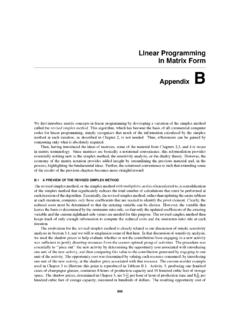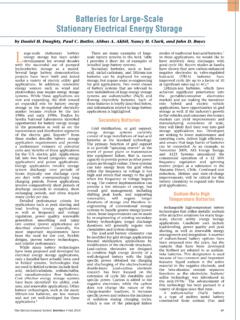Transcription of Pulsed IV, Pulsed S-Parameters and Compact Transistor Models
1 Product FeatureGaN devices have expanded into several markets offering several performance advantages. It has lead to a new gen-eration of high-power transistors as well as a wide product offering of high-power amplifier modules and systems. Compared with GaAs, GaN has a higher breakdown voltage offering a higher load-line dynamic resistance, higher power density, lower thermal resistance and higher gain with these great advantages come dis-advantages. Despite its improved thermal dis-sipation capabilities, GaN s large output power density offers higher integration that can lead to significant thermal dissipation challenges resulting in self-heating and performance deg-radation with time.
2 GaN transistors can suffer from trapping effects in the surface passivation along the gate width, leading to a decrease in threshold voltage and an increase in gate leak-age current. The question becomes, how does one accurately characterize a technology that suffers from self-heating and trapping, and how does one develop accurate linear and non-linear Transistor Models ? The answer lies in the BILT/IVCAD Pulsed IV, Pulsed S-Parameter and Compact Transistor Modeling IV, Pulsed s-Parameter and Compact Transistor modelIng systemThe BILT/IVCAD Pulsed characteriza-tion system is a joint development between AMCAD Engineering and Maury Microwave Corp.
3 It consists of three parts: a mainframe, input and output pulsers, and IVCAD mea-surement and modeling characterization BILT mainframe is the backbone of the Pulsed characterization system and includes five embedded DC power supplies, hardware synchronization/triggering to control external instruments, GPIB/LAN communication and internal calibration standards. The mainframe is designed to fit a standard 19" MicrowaveOntario, CA106 MICROWAVE JOURNAL n APRIL 2012 Pulsed IV, Pulsed S-Parameters and Compact Transistor ModelsProduct Feature108 MICROWAVE JOURNAL n APRIL 2012pulser is equipped with an electronic fuse for system protection.
4 The fast-switching circuitry activates within 70 nS, thereby offering protection to the Transistor , probes, components and test Measurement and Modeling Characterization SoftwareIVCAD is a comprehensive soft-ware suite that offers a wide array of measurement and modeling device characterization tools including: DC-IV and S-Parameters , Pulsed IV and Pulsed S-Parameters , Harmonic Load Pull, Compact Transistor Modeling, Behavioral Modeling, advanced visu-alization and data analysis and regard to GaN technology, the development of linear and non-linear Models first stems from Pulsed IV and Pulsed S-Parameter measure-ments. Current-Voltage (IV) measure-ments are used to describe the rela-PulsersInput and out-put pulsers (also re-ferred to as probes or pulse heads) are available in four Models .
5 The AM211 has been specifically designed for pulsing the input (gate) of the Transistor , while the AM221, AM222 and AM223 have been designed for pulsing the output (drain) of the tran-sistor (see Table 1).Each drain puls-er is capable of inde-pendently control-ling both quiescent and hot voltages, al-lowing for full flexibility in Pulsed IV configuration. This is achieved by us-ing several separate DC sources, large storage capacitors, a pulse amplifier for the gate and extremely fast MOS-FET switching for the drain as shown in Figure embedded acquisition and measurement hardware contained within each pulser is actually com-prised of two separate A/D convert-ers; one used for low current measure-ments and the other for high current measurements.
6 Each A/D converter has 16-bit measurement capability, resulting in both fast and accurate voltage and current measurements with a typical measurement accuracy of percent. When comparing with an oscilloscope, the embedded mea-surement system offers the equiva-lent of 50 Msamples/s and 10 MHz bandwidth for pulse monitoring. Each s Fig. 1 Pulser block PROBEGATE PULSE LENGTHDRAIN PULSE LENGTHIg IdSWITCHSWITCH+ + + + Vds HIGHVgs HIGHVgs LOWVds HIGHVgs HIGHVds LOWVds LOWVdsVgs LOWPOWERAMPRF FETGSDGNDGNDVgsPOWERDCSOURCESTORAGECAPAC ITORSLINEAR DROPDRAIN PROBEtaBle IPulser Models and sPeCIfICatIonsAM211AM221AM222AM223 Max Voltage 15 V250 V120 V-5/+15 VMax Current ( Pulsed ) 200 mA10 A30 A 200 mAMax Current (DC)200 mA3 A4 A200 mAPeak Power3 W2 kW2 kW3 WAvg Power ( Pulsed )3 W50 W50 W3 WAvg Power (DC)
7 3 W80 W80 W3 WMin Pulse Width200 nS200 nS400 ns200 nSMax Pulse Width1 ms/DC1 ms/DC1 ms/DC1 ms/DCMin Duty Cycle0%0%0%0%Max Duty Cycle*100%100%100%100%* The duty cycle must respect maximum stated average powers for each pulserProduct Feature110 MICROWAVE JOURNAL n APRIL 2012including bias and temperature. Be-cause a Transistor s performance chang-es as a function of bias (both DC and Pulsed quiescent and hot voltages), its S-Parameters must be recorded for each set of bias condi-tions. When adding a vector network analyzer (VNA) with Pulsed capabilities, such as a PNA-X, to the setup, IVCAD can measure fully synchronized Pulsed IV and Pulsed S-Parameter measure-ments, with complete fl exibility on the measurement sequence and timing within each Transistor modeling is achieved using Pulsed IV and Pulsed S-Parameter measurements to create linear, nonlinear and electro-thermal Models .
8 Pulsed S-Parameters are used to determine the Transistor s extrinsic parasitic elements, from which intrin-sic elements can be calculated. These elements are then used with the non-linear modeling engine. Pulsed IV measurements are used to determine input and output current Models , as well as gate-lag and drain-lag trap-ping effects. Synchronized Pulsed IV and Pulsed S-Parameters are used to determine one-dimensional input and output capacitance Models Cgd and Cgs. Electro-thermal Models are achieved by calculating the thermal resistances and capacitances through a controlled set of Pulsed IV measurements, and are used to model the Transistor s tem-perature BILT/IVCAD Pulsed charac-terization system is the fi rst to allow engineers and Transistor designers to characterize and model GaN FETs by performing synchronized Pulsed IV and Pulsed S-Parameter measure-ments and developing Compact Tran-sistor Models from the comfort of their microwave Corp.
9 , ontario, Ca(909) 987-4715, between input and output currents and voltages. For a typical GaN fi eld effect Transistor (FET), characterization is achieved by mea-suring output currents as a function of output voltages for a set of input voltages. Because of self-heating and trapping phenomena, it is critical to pulse the voltages between quiescent and hot states thereby reducing aver-age DC power and achieving quasi-isothermal performance. Pulse widths must be carefully selected in order to reach a steady state but not to the extent of self-heating: too short and undershoots/overshoots will invalidate the measured currents, too long and self-heating will lead to current deg-radation.
10 IVCAD offers full fl exibility on the pulse timing including pulse widths, pulse periods, duty cycles, delays and full synchronization and timing between gate and drain pulses. Enabling time domain measurements allows a user-defi ned number of IV acquisitions within each pulse and can be used to study the IV curves at user-selected traces within each pulse, including during the rise-time, over-shoot, steady state and fall-time (see Figure 2). S-Parameters are used to defi ne the electrical behavior of an n-port de-vice. With regards to two-port transis-tors, S-Parameters are used to quan-tify return loss, isolation and gain, and are essential in developing a Transistor model.






